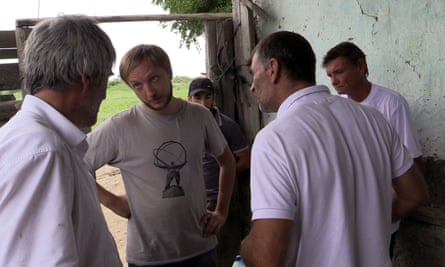It is a long, dusty drive through the mountains and valleys of Dagestan before the brick factory comes into view, its gassy haze hanging low on an otherwise empty horizon. Somewhere in this maze of kilns and clay is a man who claims he has never been paid for his work and cannot escape. Zakir Ismailov and Alexey Nikitin, activists from the Russian anti-slavery organisation Alternativa, have helped free workers like this many times. They have a standard plan: enter the factory quickly, find the person who needs rescuing, and get out before trouble starts.
It is never an easy job. More than 1 million people are believed to be trapped as modern-day slaves in Russia, many in the brick factories and kosharas (small farms) of Dagestan, a restive republic in the North Caucasus. Vagrants, soldiers and even entire families claim they have been drugged, kidnapped and forced to work against their will.
People often arrive in Dagestan under unusual circumstances. They tend to be migrants from Russia’s impoverished regions, or from former Soviet satellites, who initially head towards Moscow to find work. There, at the capital’s train stations, they are approached by recruiters who pose as employers. Well-paid jobs are touted over lunch or a drink – which the recruiters spike.
Hours later, the migrants wake up in a bus or on a train headed to a remote region like Dagestan, from where they have no means of escape.
“There are millions of people who go [to Moscow] looking for a job,” said Alexey, 31. “Tens of thousands then disappear.”
Forced labour is big in Dagestan. Recruiters earn 20,000 roubles (£285) for every person they sell into slavery, while brick-factory owners boost profits by using workers they will never have to pay.
Alexey and Zakir – former journalists turned activists – have been beaten, ridiculed and had death threats. They have faced corrupt police, apathetic politicians, powerful landowners and inconsolable relatives begging for help to find missing family members.
“It’s dangerous – really dangerous,” said Zakir, 35. “There have been occasions when people have come to the local shop where I buy food, and asked the shopkeeper to tell me that if I don’t stop saving workers from brick factories, they will kill me and blow up my family.”

Armed with little more than photos of missing persons or physical descriptions from their relatives, Alexey and Zakir do much of their work in person. But Dagestan’s hostile topography means only a fraction of those missing are ever found. “There are about 500 brick factories, and some are in the mountains, so we physically can’t cover them all,” said Zakir.
Dagestan, a majority Muslim republic, has a long history of violence. Centuries of rule by the Mongol, Persian and Ottoman empires, followed by Arab invasions and eventual annexation by tsarist Russia, has resulted in a number of armed uprisings by clans leading “jihad” against the Orthodox motherland. Locals often complain of being treated as second-class citizens in their own land. In recent years, sharia law, tribal wars and car bombs have led to Dagestan being dubbed “the most dangerous place in Europe”. In 2013, the republic was linked to the Boston marathon bombers.
Dagestan’s unforgiving landscape, coupled with the fact that many factory and farm owners confiscate workers’ documents and withhold cash, makes escape almost impossible. Even when workers do manage to leave, justice is rarely served. A soldier who went missing for a decade told police he had been enslaved for the entire period in Dagestan brick factories; sceptical officials sentenced him to two years’ imprisonment for desertion.
Coughing from the fumes of the brick factory’s kilns, which are laid out in long, block-like grids like a miniature city, Zakir and Alexey stagger along trying to determine which worker may be Dmitri. Finally, they find him – as does the factory foreman, who wants to know where he’s going.
Dmitri tells him he’s leaving for good, but first wants his pay and the return of his passport. The boss starts huffing. Other workers huddle around, wanting to know how they too can leave. “What if I’m from Donbass? We’ve just got our Russian passports,” says one man, a Ukrainian. He says he has no home to go to. “No flag, no motherland: it’s all been bombed.”

Forced labour is illegal in Russia, and Russian and Dagestani officials have been aware of the slave labour issues since 2009, when a popular TV programme, Zhdi Menia (Wait for Me), traced some missing men to brick factories. In 2013, Nariman Gadzhiyev, Dagestan’s information minister at the time, conceded that “slave labour is not a rare occurrence in Dagestan”. That same year however, the regional prosecutor’s office failed to find any evidence of slave labour during brick factory inspections.
“Slavery exists in Dagestan because people aren’t being punished for doing it,” said Alexey. “It is socially acceptable for owners to use a workforce of vulnerable people, without paying them and only providing them with food.”